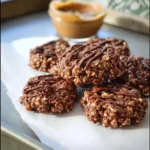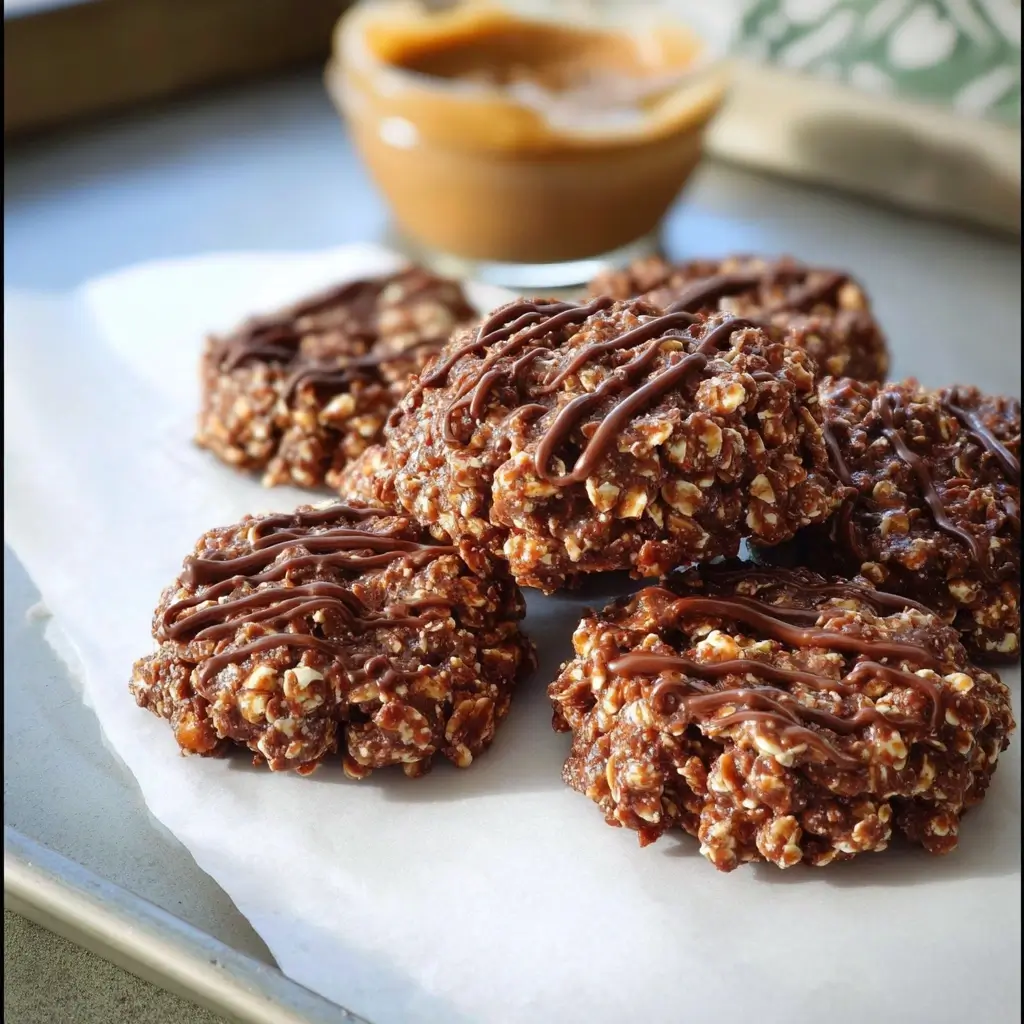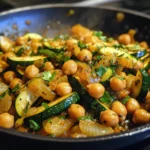Of all the treats that transport me back to childhood, no-bake cookies hold a special place. I remember standing on a stool in my grandmother’s kitchen, watching with wide-eyed wonder as she transformed a few simple pantry staples into fudgy, chocolatey mounds of goodness. The scent of bubbling chocolate and peanut butter filled the air, a promise of the perfect afternoon snack. When I transitioned to a vegan lifestyle, I was determined not to lose that cherished memory or the cookie that came with it. My first few attempts were… educational. Some were soupy disasters that never set, while others were dry, crumbly pucks. But after countless batches and meticulous tweaking, I finally landed on this recipe. This isn’t just a vegan no-bake cookie recipe; it’s the recipe. It’s the one my kids now beg for, the one I bring to potlucks where it vanishes in minutes, and the one that non-vegan friends ask for, shocked to learn it contains no dairy. It strikes the perfect balance: deeply fudgy, intensely chocolatey, with a satisfying chew from the oats and a rich, nutty depth from the peanut butter. It’s foolproof, fast, and delivers that wave of comforting nostalgia with every single bite.
The Perfect Vegan No-Bake Cookies
This recipe has been meticulously tested to ensure a perfect set every time. The key is in the ingredients you choose and the precision of the cooking time. Unlike baked cookies where you have some leeway, no-bake cookies rely on a chemical reaction—the crystallization of sugar—to achieve their signature fudgy, chewy texture. Follow these steps closely, and you’ll be rewarded with the most decadent and reliable vegan no-bake cookies you’ve ever had.
Ingredients
Here is the complete list of what you’ll need. We’ll dive into the specifics of why each ingredient is chosen and potential substitutions in a later section, as each one plays a critical role in the final outcome.
- Granulated Sugar: 2 cups (400g)
- Unsweetened Cocoa Powder: ½ cup (45g), sifted
- Vegan Butter: ½ cup (113g), stick form recommended (like Miyoko’s Kitchen or Melt Organics)
- Unsweetened Plant-Based Milk: ½ cup (120ml) (almond, soy, or oat milk all work well)
- Creamy Peanut Butter: 1 cup (256g)
- Pure Vanilla Extract: 2 teaspoons
- Fine Sea Salt: ½ teaspoon
- Quick-Cooking Oats: 3 cups (240g) (do not use old-fashioned/rolled oats or steel-cut oats)
Instructions
Follow these instructions step-by-step for guaranteed success. The process is quick, so it’s essential to have all your ingredients measured and ready before you begin (a practice known as mise en place).
1. Preparation:
Before you turn on the stove, prepare your landing zone. Line two large baking sheets with parchment paper or silicone baking mats. If you don’t have large baking sheets, you can use any flat surface like plates or countertops lined with parchment. Set them aside. This is crucial because once the cookie mixture is ready, you need to work quickly before it starts to set in the pot.
2. Combine the Base Ingredients:
In a medium-to-large saucepan (at least 3 quarts to prevent boiling over), combine the granulated sugar, unsweetened cocoa powder, vegan butter, and unsweetened plant-based milk. Place the saucepan over medium heat.
3. Melt and Dissolve:
Stir the mixture constantly with a whisk or a heat-resistant spatula as the butter melts. Continue stirring until the sugar is completely dissolved and the mixture is smooth and glossy. You shouldn’t feel any gritty sugar granules when you rub a tiny bit between your fingers (be careful, it’s hot!). This initial dissolving phase is important for a smooth, non-grainy texture.
4. The Critical Boil:
Once the mixture is smooth and begins to bubble around the edges, stop stirring. Allow it to come to a full, rolling boil. A rolling boil is one that you cannot stir down. Once it reaches this stage, set a timer for exactly 60 seconds. Do not guess. Do not walk away. This one-minute boil is the most critical step of the entire recipe. Boiling for less than a minute will result in cookies that are soft, sticky, and may not set properly. Boiling for more than a minute will cause too much moisture to evaporate, resulting in cookies that are dry, hard, and crumbly.
5. Remove from Heat and Add Flavor:
As soon as the timer goes off, immediately remove the saucepan from the heat. Place it on a heat-proof surface. Immediately stir in the creamy peanut butter, pure vanilla extract, and fine sea salt. Stir vigorously until the peanut butter is completely melted and the mixture is uniform and very glossy. The heat from the chocolate mixture is more than enough to melt the peanut butter perfectly.
6. Incorporate the Oats:
Pour in all 3 cups of the quick-cooking oats at once. Use a spatula to fold and stir them into the chocolate-peanut butter mixture until every oat is evenly coated. Work quickly but thoroughly. You will notice the mixture begins to thicken and lose some of its gloss as the oats absorb the liquid. This is what you want.
7. Scoop and Set:
Using a 1.5-tablespoon cookie scoop (or two spoons), immediately begin dropping rounded mounds of the mixture onto your prepared parchment-lined baking sheets. Space them about an inch apart. If you want flatter, more uniform cookies, you can gently press down on the top of each mound with the back of the spoon.
8. Let Them Set:
Allow the cookies to sit at room temperature for at least 30-45 minutes to cool and firm up completely. They are ready when they are no longer tacky to the touch and hold their shape when lifted. To speed up the process, you can place the baking sheets in the refrigerator for 15-20 minutes.
Nutrition Facts
- Servings: Approximately 36 cookies
- Calories per serving: Approximately 135 kcal
Disclaimer: The nutritional information provided is an estimate and can vary based on the specific brands of ingredients used.
Preparation Time
- Prep Time: 10 minutes (for measuring ingredients and preparing pans)
- Cook Time: 5-7 minutes
- Setting Time: 30-45 minutes
- Total Time: Approximately 1 hour
How to Serve Your Vegan No-Bake Cookies
These versatile cookies are more than just a simple snack. Their rich flavor and satisfying texture make them suitable for a variety of occasions and pairings. Here are some creative ways to serve them:
- The Classic Afternoon Snack:
- Serve them on a platter with a tall glass of cold plant-based milk (oat milk is particularly creamy and delicious with these).
- Pair with a hot cup of coffee or tea for a perfect mid-day pick-me-up. The bitterness of the coffee beautifully contrasts the sweetness of the cookie.
- For Parties and Potlucks:
- Arrange them on a multi-tiered dessert stand to create an impressive display.
- Create a cookie platter by mixing them with other vegan treats like chocolate chip cookies or vegan brownies for a variety of textures and flavors.
- They are a guaranteed hit at bake sales as they are allergen-friendly for those avoiding dairy and eggs. Be sure to label them “Vegan”!
- As a Decadent Dessert:
- Serve one or two cookies slightly warmed (a few seconds in the microwave) alongside a scoop of high-quality vegan vanilla bean or coffee-flavored ice cream.
- Create a “cookie sundae” by crumbling a cookie over a bowl of vegan ice cream and finishing with a drizzle of vegan caramel sauce or extra melted chocolate.
- For an elegant touch, dust the cookies with a little extra cocoa powder or powdered sugar just before serving.
- Holiday and Gifting Ideas:
- During the holidays, add a pinch of peppermint extract along with the vanilla and top with crushed candy canes for a festive twist.
- For Valentine’s Day or birthdays, add some festive vegan sprinkles on top of the cookies before they set.
- Package them in a beautiful tin or a cellophane bag tied with a ribbon for a thoughtful and delicious homemade gift for neighbors, teachers, or friends.
Additional Tips for Perfect No-Bake Cookies
Achieving the perfect no-bake cookie is a science. Here are five essential tips to ensure your cookies are never too wet, never too dry, but always just right.
1. The One-Minute Boil is a Golden Rule, Not a Suggestion
We mentioned it in the instructions, but it bears repeating because it is the single most important factor for success. The purpose of boiling the sugar, butter, and milk mixture is to cook it to the “soft-ball stage” of candy making (around 235-245°F or 112-116°C). This specific temperature ensures that when the mixture cools, the sugar will crystallize just enough to form a stable, fudgy structure that holds the oats together. A timer is your best friend here. Start it only when the mixture reaches a full, rolling boil that can’t be stirred down. One minute is the magic number for the quantities in this recipe.
2. The Right Oats are Crucial for Texture
The type of oats you use dramatically affects the final texture.
- Quick-Cooking Oats: These are the best choice. They are cut smaller and rolled thinner, so they absorb the liquid quickly and create a chewy, cohesive cookie without needing a long time to soften.
- Old-Fashioned (Rolled) Oats: These are larger and thicker. If you use them, your cookies will have a much tougher, chewier, and less integrated texture. They may also not absorb enough liquid, which can lead to a wetter cookie. If you only have rolled oats, you can pulse them in a food processor 2-3 times to break them down slightly, but quick-oats are still superior.
- Steel-Cut Oats: Do not use these. They are far too hard and will not soften, resulting in a gritty, unpleasant texture.
3. Use High-Quality, Stick-Form Vegan Butter
The type of vegan butter matters. For baking and candy-making, stick-form vegan butter (like Miyoko’s Kitchen Cultured Vegan Butter or Melt Organic Vegan Butter) is formulated to mimic the water and fat content of dairy butter. Tub-style vegan margarines often have a higher water content and more air whipped into them, which can throw off the liquid-to-solid ratio in the recipe and lead to setting issues. Coconut oil can be used as a substitute, but it will impart a coconut flavor and may result in a slightly firmer, less “buttery” cookie.
4. Work Fast Once the Oats are In
As soon as you remove the chocolate mixture from the heat and stir in the oats, the setting process begins. The mixture will start to cool and thicken rapidly. You need to scoop the cookies onto your prepared sheets without delay. If you wait too long, the mixture will become stiff and difficult to scoop, and the cookies will be more lumpy and less uniform. Have your cookie scoop and parchment paper ready to go before you even start the boiling process.
5. Proper Storage for Lasting Freshness
No-bake cookies are best enjoyed within a few days, but proper storage can keep them delicious for longer.
- Store the completely cooled cookies in an airtight container at room temperature.
- Place sheets of wax paper or parchment paper between the layers of cookies to prevent them from sticking together.
- They will stay fresh at room temperature for up to 5 days. For longer storage, you can keep them in an airtight container in the refrigerator for up to 2 weeks. Note that refrigeration can make them a bit harder, so let them sit at room temperature for 10-15 minutes before enjoying.
Frequently Asked Questions (FAQ)
Here are answers to some of the most common questions about making perfect vegan no-bake cookies.
1. Q: Help! My cookies are runny and didn’t set. What went wrong?
A: This is the most common issue, and 99% of the time, the cause is not boiling the sugar mixture for long enough. The mixture did not reach the proper temperature to crystallize upon cooling. It’s crucial to let the mixture come to a full, churning, rolling boil and then time it for exactly 60 seconds. A gentle simmer is not enough. The weather can also play a small role; very high humidity can sometimes make it harder for cookies to set. If this happens, you can try refrigerating them for a longer period, but the best fix is prevention on the next batch by ensuring a proper boil.
2. Q: My cookies turned out dry and crumbly. How can I fix this?
A: This is the opposite problem of runny cookies and is almost always caused by boiling the mixture for too long. Boiling for more than the prescribed minute causes too much water to evaporate. This concentrates the sugar and results in a hard, dry final product that crumbles instead of holding its shape. Again, using a timer is the best way to prevent this. Another less common cause could be adding too many oats, so be sure to measure your ingredients accurately using standard measuring cups.
3. Q: Can I make this recipe gluten-free?
A: Absolutely! This recipe is very easy to make gluten-free. Oats are naturally gluten-free, but they are often processed in facilities that also handle wheat, barley, and rye, leading to cross-contamination. To ensure the recipe is completely gluten-free, simply purchase oats that are explicitly labeled and certified as “gluten-free.” All other ingredients in the recipe are typically gluten-free, but it’s always wise to double-check labels, especially on cocoa powder and vanilla extract.
4. Q: Can I reduce the amount of sugar in this recipe?
A: While you can slightly reduce the sugar, it’s not recommended to make a drastic change. In no-bake cookies, sugar does more than just add sweetness; it’s a primary structural ingredient. The process of dissolving and then re-crystallizing the sugar is what creates the “glue” that holds the cookie together. Significantly reducing the sugar will likely result in cookies that fail to set properly. If you want to experiment, try reducing the sugar by a quarter cup (50g) at most and see how it affects the final texture. Do not substitute it with a liquid sweetener like maple syrup, as this will throw off the liquid ratios entirely.
5. Q: Can I use a different nut butter or make these nut-free?
A: Yes, you can! While classic no-bakes use peanut butter, this recipe is delicious with other nut butters.
- Almond Butter: This works beautifully and provides a slightly more subtle, toasty flavor.
- Cashew Butter: This will give the cookies an extra creamy and mild, sweet flavor.
- For a Nut-Free Version: Sunflower seed butter (like SunButter) is an excellent one-to-one substitute for peanut butter. It will give the cookies a distinct, earthy flavor that is also delicious. Tahini (sesame seed paste) can also work, but it has a much stronger, more bitter flavor profile that may not be to everyone’s liking. When using any alternative, opt for a creamy, well-stirred variety for the best results.

Vegan No-Bake Cookies Recipe
Ingredients
- Granulated Sugar: 2 cups (400g)
- Unsweetened Cocoa Powder: ½ cup (45g), sifted
- Vegan Butter: ½ cup (113g), stick form recommended (like Miyoko’s Kitchen or Melt Organics)
- Unsweetened Plant-Based Milk: ½ cup (120ml) (almond, soy, or oat milk all work well)
- Creamy Peanut Butter: 1 cup (256g)
- Pure Vanilla Extract: 2 teaspoons
- Fine Sea Salt: ½ teaspoon
- Quick-Cooking Oats: 3 cups (240g) (do not use old-fashioned/rolled oats or steel-cut oats)
Instructions
1. Preparation:
Before you turn on the stove, prepare your landing zone. Line two large baking sheets with parchment paper or silicone baking mats. If you don’t have large baking sheets, you can use any flat surface like plates or countertops lined with parchment. Set them aside. This is crucial because once the cookie mixture is ready, you need to work quickly before it starts to set in the pot.
2. Combine the Base Ingredients:
In a medium-to-large saucepan (at least 3 quarts to prevent boiling over), combine the granulated sugar, unsweetened cocoa powder, vegan butter, and unsweetened plant-based milk. Place the saucepan over medium heat.
3. Melt and Dissolve:
Stir the mixture constantly with a whisk or a heat-resistant spatula as the butter melts. Continue stirring until the sugar is completely dissolved and the mixture is smooth and glossy. You shouldn’t feel any gritty sugar granules when you rub a tiny bit between your fingers (be careful, it’s hot!). This initial dissolving phase is important for a smooth, non-grainy texture.
4. The Critical Boil:
Once the mixture is smooth and begins to bubble around the edges, stop stirring. Allow it to come to a full, rolling boil. A rolling boil is one that you cannot stir down. Once it reaches this stage, set a timer for exactly 60 seconds. Do not guess. Do not walk away. This one-minute boil is the most critical step of the entire recipe. Boiling for less than a minute will result in cookies that are soft, sticky, and may not set properly. Boiling for more than a minute will cause too much moisture to evaporate, resulting in cookies that are dry, hard, and crumbly.
5. Remove from Heat and Add Flavor:
As soon as the timer goes off, immediately remove the saucepan from the heat. Place it on a heat-proof surface. Immediately stir in the creamy peanut butter, pure vanilla extract, and fine sea salt. Stir vigorously until the peanut butter is completely melted and the mixture is uniform and very glossy. The heat from the chocolate mixture is more than enough to melt the peanut butter perfectly.
6. Incorporate the Oats:
Pour in all 3 cups of the quick-cooking oats at once. Use a spatula to fold and stir them into the chocolate-peanut butter mixture until every oat is evenly coated. Work quickly but thoroughly. You will notice the mixture begins to thicken and lose some of its gloss as the oats absorb the liquid. This is what you want.
7. Scoop and Set:
Using a 1.5-tablespoon cookie scoop (or two spoons), immediately begin dropping rounded mounds of the mixture onto your prepared parchment-lined baking sheets. Space them about an inch apart. If you want flatter, more uniform cookies, you can gently press down on the top of each mound with the back of the spoon.
8. Let Them Set:
Allow the cookies to sit at room temperature for at least 30-45 minutes to cool and firm up completely. They are ready when they are no longer tacky to the touch and hold their shape when lifted. To speed up the process, you can place the baking sheets in the refrigerator for 15-20 minutes.
Nutrition
- Serving Size: One Normal Portion
- Calories: 135





